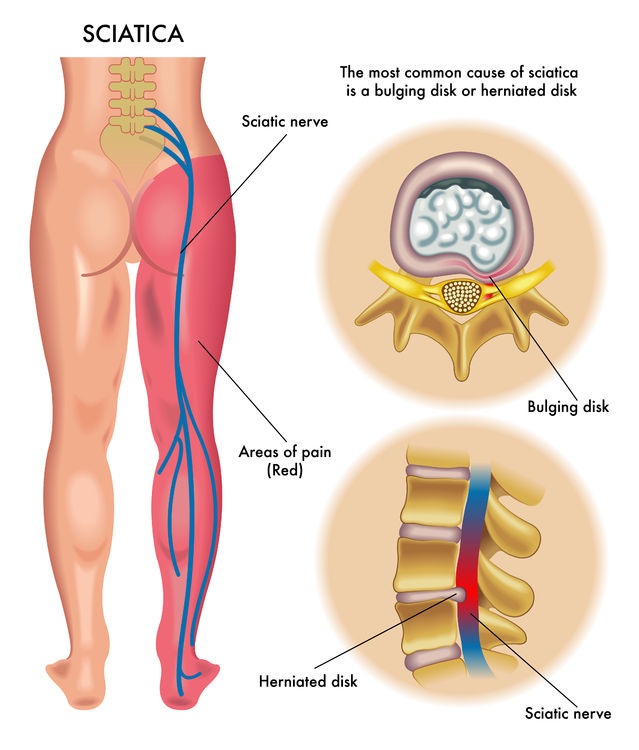3 Exercises For Sciatica
Sciatica is a type of back pain.
Sciatica is a type of back pain that involves your sciatic nerve being irritated in some way. It can be uncomfortable at best and debilitating at worst. It’s most common cause is compression of the sciatic nerve by a herniated disc.
The most obvious symptoms for sciatica is pain in the lower back, buttocks, knee, and leg. Pain is limited to one side and will be at its worst when you’re hunched over with your spine in flexion (like sitting at a desk typing for example).
Understand your body.
Understanding your sciatica and what is going on within your body can make sciatica less daunting, especially if you’re in pain. Take control of the situation and work towards pain free living by learning where it comes from and easy steps you can take to resolving it.
The Sciatic Nerve.
The sciatic nerve is the largest nerve in your body, running from the lower back all the way down to the leg and into the foot. Because of this, irritation to the nerve can result in pain being felt anywhere along this path. The pain is usually worst where the nerve attaches to the spine (roots of L4-S3), in the lower back.
Disc Herniation.
A disc is herniated when it is bulging out past the spinal processes that surrounds it. It can push out against the surrounding nerve roots, causing pain and the symptoms we call sciatica. It can also cause other types of back pain.
One of the most common causes of a herniated disc is when it is compressed in flexion (often with rotation and load) repeatedly. For example; sitting hunched over and bending over to pick things up can cause our spinal vertebrae to ‘squish’ the spinal discs outwards, closer to the surface of the skin, as pictured below.
NOTE: It’s important to keep in mind that just being in this position doesn't cause a herniated disc. It is when we repeat this. When the only pattern we have access to is local flexion, the stress placed on the spinal discs can increase the chance of disc herniation, especially if repeatedly loaded in this way.
Variety is important.
This is why movement through a range of positions is important. We’re not designed to be in one position or posture. We’re designed to move. Movement keeps us healthy.
Read our blog on movement here:
Back extensions: the most prescribed back pain rehab exercise.
The opposite to flexion is extension. With the spine in extension (which most of us are not often in), our spinal vertebrae ‘squish’ the spinal discs back inwards to a less aggravating position. This tends to reduce the pressure against the sciatic nerve, reducing pain.
NOTE: That does not mean you should avoid flexion and only use extension for every movement. You can over-work your body in any one position. So practice both. Start with extension initially to reduce the tension on the sciatic nerve.
Rehab doesn’t stop when you’re out of initial pain.
We have to work on the causes of the pain, not just the pain itself. Once pressure on the nerve root has been reduced to a manageable level, it opens up new movement possibilities that we have to strengthen to reduce the chances of pain or injury occurring again.
Ongoing treatment would expand on this new pain free position by developing healthy movement patterns that better position the discs and prepare them for load, such as the hinge pattern and the squat pattern. Strengthening these movement patterns will give you further ability to engage in activities that are meaningful to you, like playing with your children or kicking a football around.
Here are three exercises you can start today to help reduce/eliminate pain resulting from a herniated disc.
1. Lumbar Extensions.
To encourage a herniated disc to return to its proper position we essentially want to push it back in a controlled manner by doing lumbar extensions. This should be done with minimal back muscle engagement at this stage as not to aggravate into a spasm. This exercise should be done at the site of the pain.
Begin by laying down on your stomach.
With your elbows underneath your shoulders, push your chest towards the ceiling, while keeping your ribs down.
Keeping your chin tucked and hips down helps maintain a good position and to direct the movement to the site of the pain.
Keep the weight in your arms.
Repeat this movement for 3 to 4 sets of 5 repetitions, making sure your movement is controlled.
2. Pelvic Tilts
Pelvic tilts help increase proprioception (awareness of your body in space) and control in your hips and lower back. Practicing this movement will help you control your hips and lower back. Just like with lumbar extensions, pelvic tilts will encourage the disc to return to its proper position.
Begin in a crawling position, on your knees and hands. Knees should be directly under hips and hands directly under shoulders.
Push into the ground with your shoulders. Hold this position.
Very slowly and with as much control as you can, tilt your pelvis, dipping your lower back as far as you can towards the ground and then raise it as high as you can by tucking the pelvis down.
It’s important to make sure the upper body stays fixed in its position as we’re just trying to gain more control over the lower back and hips
Repeat this exercise for 3 to 4 rounds of 10 repetitions.
3. Nerve Stretch
The sciatic nerve can be stretched a little like a muscle can be. This will help reduce pain and nerve tension immediately, which allows for further movement required to fix sciatica. We recommend using a mobility band to help assist in this exercise.
Begin by hooking a mobility band over your foot.
Hunched forward towards your feet until you feel a mild stretch.
Keeping the knee down, pull the band with your arms so that the stretch increases.
Repeat this in a controlled manner for 2 to 3 sets of 40 seconds on each leg.
Give these a go and let us know how you get on! Don't forget to share the love to somebody working on their sciatica!
Author: Ben Means
ONI Personal Training | Massage Therapy | Nutrition Coaching


